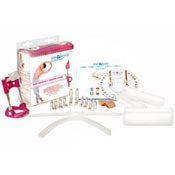Peyronie's Surgery
There are several Peyronie's surgical treatments available, the most common are plication, grafting and penile implants.

Peyronie's surgery is always your last treatment option. Most men with Peyronie's disease have exhausted the non-surgical treatment options prior to opting for penis surgery.
In this section, you will find comprehensive information about the main Peyronie's surgical options. I go through the benefits, possible side effects, the risk involved, potential results, scientific support and which surgical option is most suitable based on your Peyronie's condition.
What Can You Expect From Your Peyronie's Surgery?
The main goal of Peyronie's surgical treatments is to correct penis curvature. It can be either a penis cosmetic surgery but it is usually also a functional operation.
Functional operation applies when the penis curvature / deformity is very severe, thus hindering normal sexual intercourse, and/or if erectile dysfunction is part of your Peyronie's symptoms.
Simply put, penis curvature is because one side of the penis is longer than the opposite side. The goal of any penis surgery is therefore to make the two sides equal in length. There are two ways to achieve this. By shortening the longer side (plication) or by lengthening the shorter side (grafting).
Peyronie's disease surgery is an invasive procedure. The inherent risk and severity of possible side effects mean that penile surgery is usually the last treatment option.
Most men with Peyronie's disease have tried some or many non-surgical treatment options prior to opting for penis surgery.
It is important to have realistic expectations for the outcome of Peyronie's surgery, i.e. what the surgery achieves (corrects penis curvature) and what it does not do (improveme libido or lengthen the penis).
What Is The Risk Of Peyronie's Surgery?
Peyronie's disease surgery is an invasive procedure and as such involves some level of risk. There can be complications during surgery (anesthesia, bleeding) or post surgery (infections, delayed healing).
Potential side effects from penis surgery are several and some can be serious, like the risk of erectile dysfunction / impotence, penile shortening, loss of elasticity and reduced penile sensation.
Make sure you understand the risk involved and the possible side effects. Your doctor should discuss them with you during your initial consultancy meeting.
The articles in this section will give you sufficient information to prepare yourself properly in advance of your doctor’s appointment.
Peyronie's surgery should only be considered on expert advice, i.e. doctor that specializes in the Peyronie's disease. And I guess it goes without saying that you only want experienced Peyronie's surgeon to perform this important operation on you.
Pros And Cons Of Peyronie's Disease Surgery
Penis cosmetic surgery is still the most reliable way to correct penis deformity associated with Peyronie's disease. It is the most effective way to straighten bent penis. It is not a quick fix but Peyronie's surgery offers the most rapid and reliable penis cosmetic result (straight penis).
Penis surgery may be the only treatment option available for some men with Peyronie's disease, not least for those with the most severe condition (> 60 degree curvature).
On the downside are the risks and possible side effects, which both can be considerable. Furthermore, Peyronie's surgery is the most expensive treatment option. The cost can easily run into thousands of US dollars.
Find out what Dr. Levine, one of the best known Peyronie's specialists in the world today, has to say about the benefits, side effects and results from the different Peyronie's surgeries.
Who Is A Candidate For Penile Surgery?
In my mind, surgery is always the last Peyronie's treatment option. Penis surgery is only performed several months after your Peyronie's disease has reached the stable phase. If you attempt a surgery before you have reached this stage, your penis is likely to continue bending after surgery.
You should use the time during the acute phase to try some of the non-surgical Peyronie's Disease Treatments options available. And hopefully like me, you will not need a Peyronie's surgery.
However, if you do need a Peyronie's disease surgery then the type of surgery you require depends on your Peyronie's condition, not on your preference.
No single surgery treats all Peyronie's patients successfully. Individualized approach is therefore the best approach when determining the appropriate surgical option.
Before recommending surgical approach (and then which one), your doctor will evaluate the nature of the penis deformity in terms of curvature, hinge effect and hourglass deformity, as well as the erectile capacity.
Suitable candidates for Peyronie's surgery include men with stable, painless deformity with compromised ability, or inability, to engage in sexual intercourse because of penis deformity or diminished rigidity.
Surgery to correct penis curvature does not generally correct problems with penis rigidity. Men with Erectile Dysfunction may therefore have to be treated for ED prior to undergoing penile surgery.
Men with extensive plaque calcifications are also considered suitable candidates for Peyronie's disease surgery, as extensive calcification tends to respond poorly to medical treatment.
Men that have reached the stable stage with only mild or moderate penis curvature that does not interfere with sexual intercourse are usually discouraged from undergoing penile surgery. The potential side effects are considered not worth the risk. They should consider other non-surgical Peyronie's treatment options.
My Peyronie's Surgery Comparison will help you to compare the different surgical treatments available and to find out if they are suitable for you.
Available Peyronie's Surgical Treatments
Below is summary of the main surgical treatments available to Peyronie's patients. The order does not represent the expected result from the treatments. It is based on the severity of the Peyronie's symptoms, i.e. from the mildest (mild curvature) to the most severe (erectile dysfunction).
Click on the surgery names below to see the full details and references to scientific studies.
Plication
Plication Surgery is a penis cosmetic surgery that involves pinching together the tissue on the outer side (opposite) of the bend. The ideal candidate for plication surgery can achieve erection, has adequate penile length and moderate penile curvature without any associated deformity.
The long-term results are promising, low rate of penile curvature reappearance and high patient satisfaction with the cosmetic results achieved by the surgery.
Grafting
Grafting Surgery is a surgical procedure that involves replacing or expanding scarred penile tissue with healthy tissue (grafts). Grafting offers good cosmetic correction for men with severe penile deformity.
There are some long-term risks associated with the grafting procedure, e.g. curvature recurrence and new onset of erectile dysfunction. This means that long-term follow ups tend to show low patient satisfaction.
Penile Implants
Penis Implants are reserved for men with erectile dysfunction that have not achieved satisfying result with other treatments on offer.
The level of satisfaction is high among men that keep their expectations realistic. Penis implants can give you straight looking penis and elicit erection on demand, but it will not make the penis longer nor boost your sex drive.
Peyronie's surgery is always the last treatment option and should only be considered after other options have been fully explored without satisfying result.
If you are in the acute phase of your Peyronie's, make sure you start treatment that will stop the progression of the disease and ideally reverse the curvature.
Use medically approved Traction Device and / or Vacuum Pump in conjunction with medication that has been shown to be effective (oral or injections). Your goal is to avoid getting severely deformed penis that will require surgical procedure to correct.
However, if you feel you have fully explored the non-surgical Peyronie's treatment options available for you, then Peyronie's surgery might be the next step for you.
Ps. If you have already had, or are planning to have a penis surgery, then you should consider using Traction Device to prevent post-surgical penile shortening.






